Abstract
A model of the evolutionary dynamics of a multigene family in a finite population under the joint effects of selection and (possibly biased) gene conversion is analyzed. It is assumed that the loss or fixation of a polymorphism at any particular locus in the gene family occurs on a much faster time scale than the introduction of new alleles to a monomorphic locus by gene conversion. A general formula for the fixation of a new allele throughout a multigene family for a wide class of selection functions with biased gene conversion is given for this assumption. Analysis for the case of additive selection shows that (i) unless selection is extremely weak or bias is exceptionally strong, selection usually dominates the fixation dynamics, (ii) if selection is very weak, then even a slight conversion bias can greatly alter the fixation probabilities, and (iii) if both selection and conversion bias are sufficiently small, the substitution rate of new alleles throughout a multigene family is approximately the single locus mutation rate, the same result as for neutral alleles at a single-copy gene. Finally, I analyze a fairly general class of underdominant speciation models involving multigene families, concluding for these models under weak conversion that although the probability of fixation may be relatively high, the expected time to fixation is extremely long, so that speciation by "molecular drive" is unlikely. Furthermore, speciation occurs faster by fixing underdominant alleles of the same effect at single-copy genes than by fixing the same number of loci in a single multigene family under the joint effects of selection, conversion, and drift.
Full text
PDF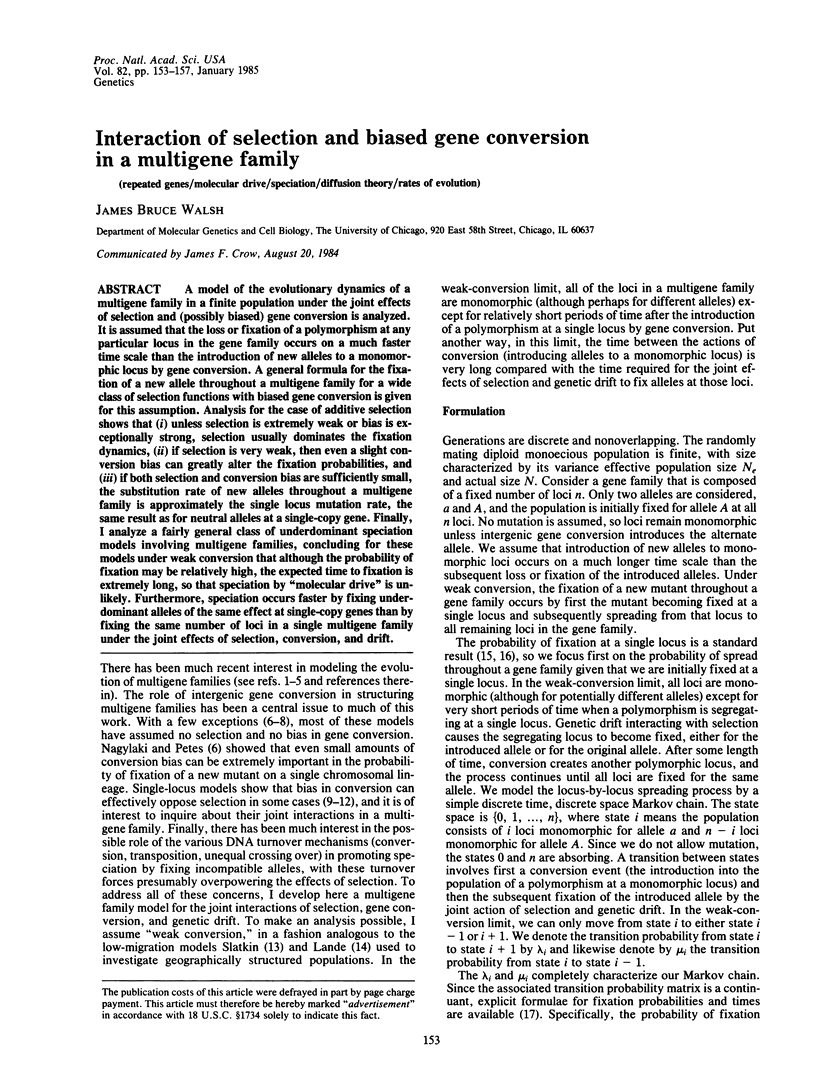
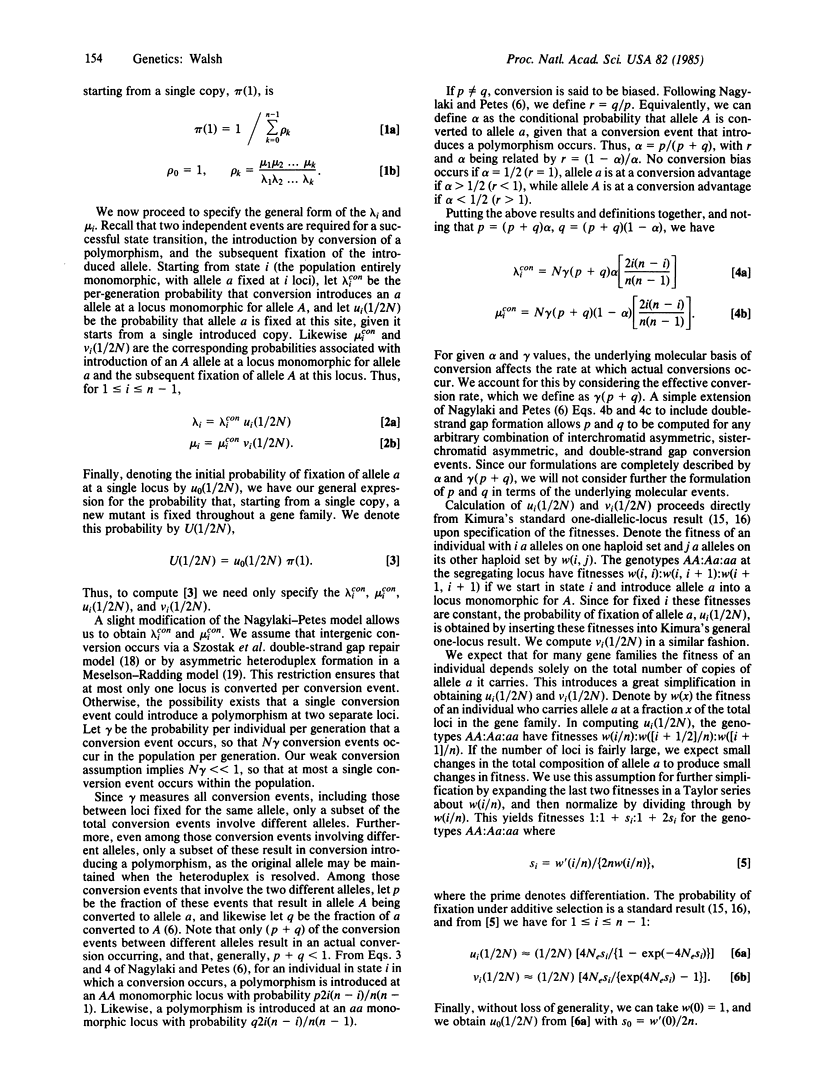
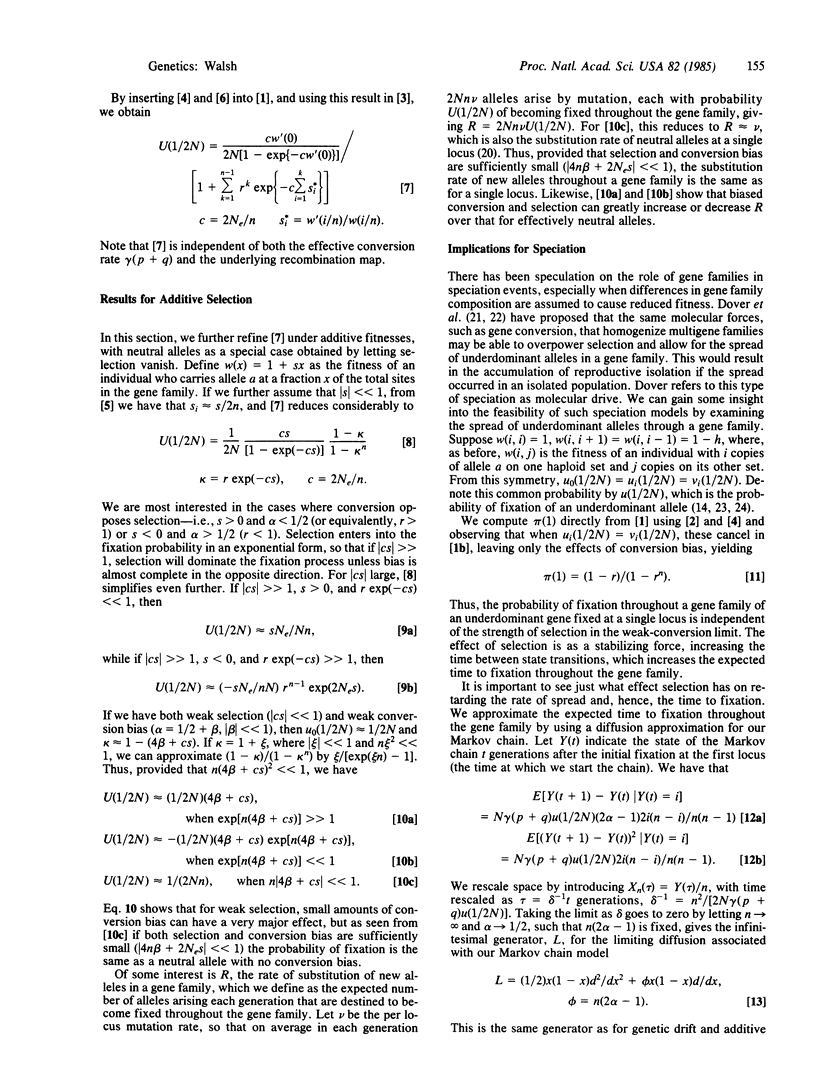
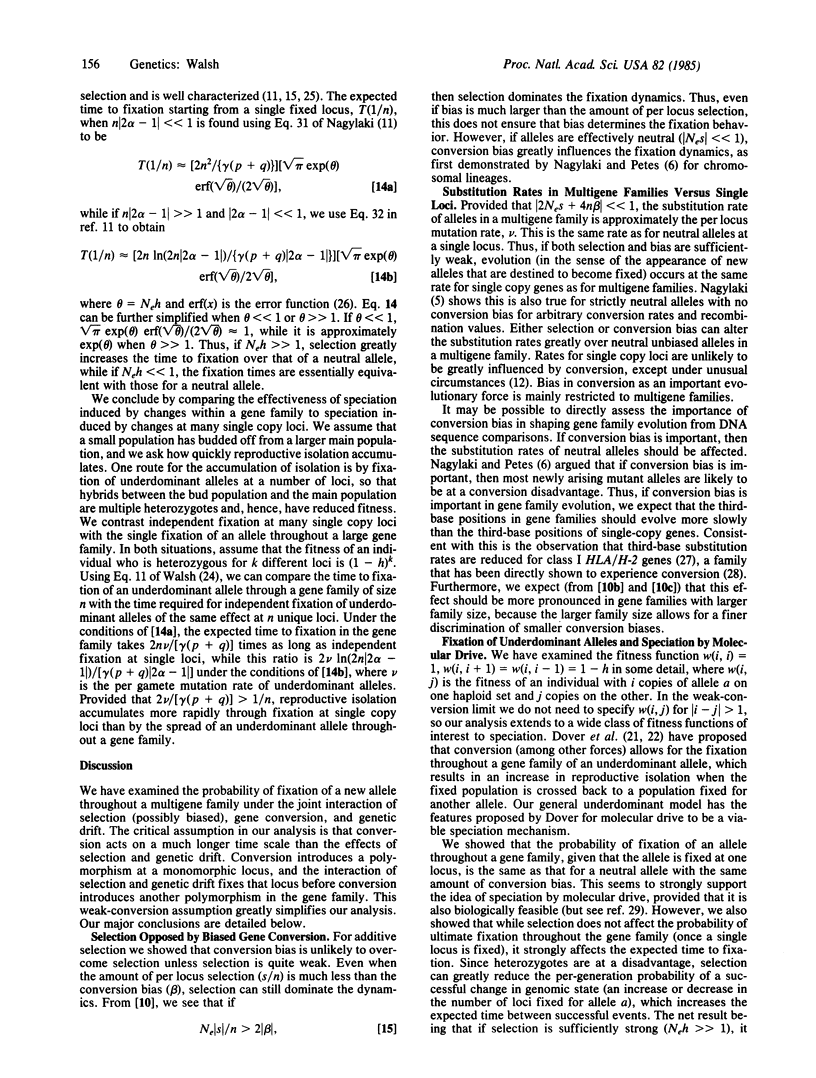
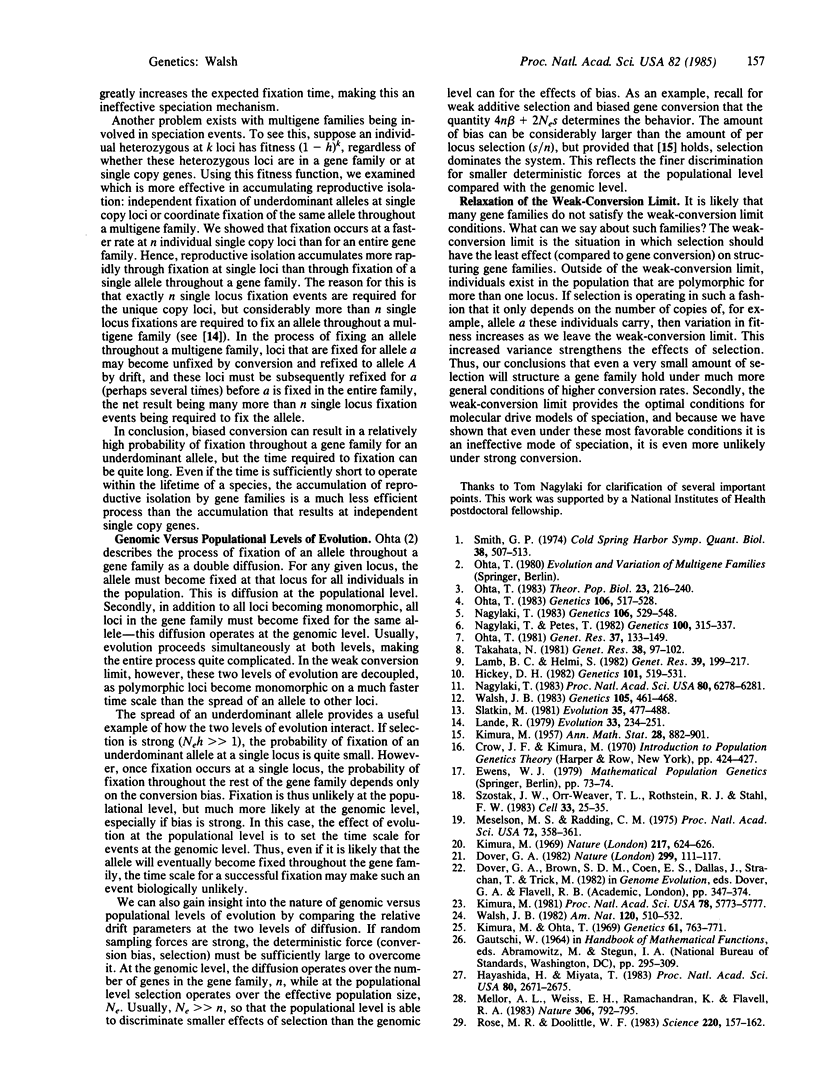
Selected References
These references are in PubMed. This may not be the complete list of references from this article.
- Dover G. Molecular drive: a cohesive mode of species evolution. Nature. 1982 Sep 9;299(5879):111–117. doi: 10.1038/299111a0. [DOI] [PubMed] [Google Scholar]
- Hayashida H., Miyata T. Unusual evolutionary conservation and frequent DNA segment exchange in class I genes of the major histocompatibility complex. Proc Natl Acad Sci U S A. 1983 May;80(9):2671–2675. doi: 10.1073/pnas.80.9.2671. [DOI] [PMC free article] [PubMed] [Google Scholar]
- Hickey D. A. Selfish DNA: a sexually-transmitted nuclear parasite. Genetics. 1982 Jul-Aug;101(3-4):519–531. doi: 10.1093/genetics/101.3-4.519. [DOI] [PMC free article] [PubMed] [Google Scholar]
- Kimura M. Evolutionary rate at the molecular level. Nature. 1968 Feb 17;217(5129):624–626. doi: 10.1038/217624a0. [DOI] [PubMed] [Google Scholar]
- Kimura M., Ohta T. The Average Number of Generations until Fixation of a Mutant Gene in a Finite Population. Genetics. 1969 Mar;61(3):763–771. doi: 10.1093/genetics/61.3.763. [DOI] [PMC free article] [PubMed] [Google Scholar]
- Kimura M. Possibility of extensive neutral evolution under stabilizing selection with special reference to nonrandom usage of synonymous codons. Proc Natl Acad Sci U S A. 1981 Sep;78(9):5773–5777. doi: 10.1073/pnas.78.9.5773. [DOI] [PMC free article] [PubMed] [Google Scholar]
- Mellor A. L., Weiss E. H., Ramachandran K., Flavell R. A. A potential donor gene for the bm1 gene conversion event in the C57BL mouse. Nature. 1983 Dec 22;306(5945):792–795. doi: 10.1038/306792a0. [DOI] [PubMed] [Google Scholar]
- Meselson M. S., Radding C. M. A general model for genetic recombination. Proc Natl Acad Sci U S A. 1975 Jan;72(1):358–361. doi: 10.1073/pnas.72.1.358. [DOI] [PMC free article] [PubMed] [Google Scholar]
- Nagylaki T. Evolution of a finite population under gene conversion. Proc Natl Acad Sci U S A. 1983 Oct;80(20):6278–6281. doi: 10.1073/pnas.80.20.6278. [DOI] [PMC free article] [PubMed] [Google Scholar]
- Nagylaki T., Petes T. D. Intrachromosomal gene conversion and the maintenance of sequence homogeneity among repeated genes. Genetics. 1982 Feb;100(2):315–337. doi: 10.1093/genetics/100.2.315. [DOI] [PMC free article] [PubMed] [Google Scholar]
- Nagylaki T. The evolution of multigene families under intrachromosomal gene conversion. Genetics. 1984 Mar;106(3):529–548. doi: 10.1093/genetics/106.3.529. [DOI] [PMC free article] [PubMed] [Google Scholar]
- Ohta T. Genetic variation in small multigene families. Genet Res. 1981 Apr;37(2):133–149. doi: 10.1017/s0016672300020115. [DOI] [PubMed] [Google Scholar]
- Ohta T. On the evolution of multigene families. Theor Popul Biol. 1983 Apr;23(2):216–240. doi: 10.1016/0040-5809(83)90015-1. [DOI] [PubMed] [Google Scholar]
- Ohta T. Some models of gene conversion for treating the evolution of multigene families. Genetics. 1984 Mar;106(3):517–528. doi: 10.1093/genetics/106.3.517. [DOI] [PMC free article] [PubMed] [Google Scholar]
- Rose M. R., Doolittle W. F. Molecular biological mechanisms of speciation. Science. 1983 Apr 8;220(4593):157–162. doi: 10.1126/science.220.4593.157. [DOI] [PubMed] [Google Scholar]
- Smith G. P. Unequal crossover and the evolution of multigene families. Cold Spring Harb Symp Quant Biol. 1974;38:507–513. doi: 10.1101/sqb.1974.038.01.055. [DOI] [PubMed] [Google Scholar]
- Szostak J. W., Orr-Weaver T. L., Rothstein R. J., Stahl F. W. The double-strand-break repair model for recombination. Cell. 1983 May;33(1):25–35. doi: 10.1016/0092-8674(83)90331-8. [DOI] [PubMed] [Google Scholar]
- Walsh J. B. Role of biased gene conversion in one-locus neutral theory and genome evolution. Genetics. 1983 Oct;105(2):461–468. doi: 10.1093/genetics/105.2.461. [DOI] [PMC free article] [PubMed] [Google Scholar]


